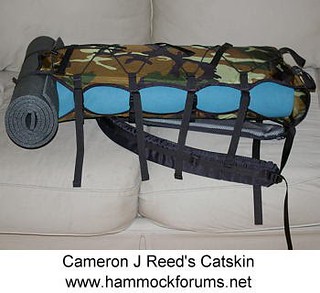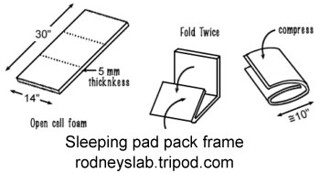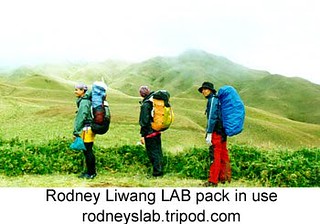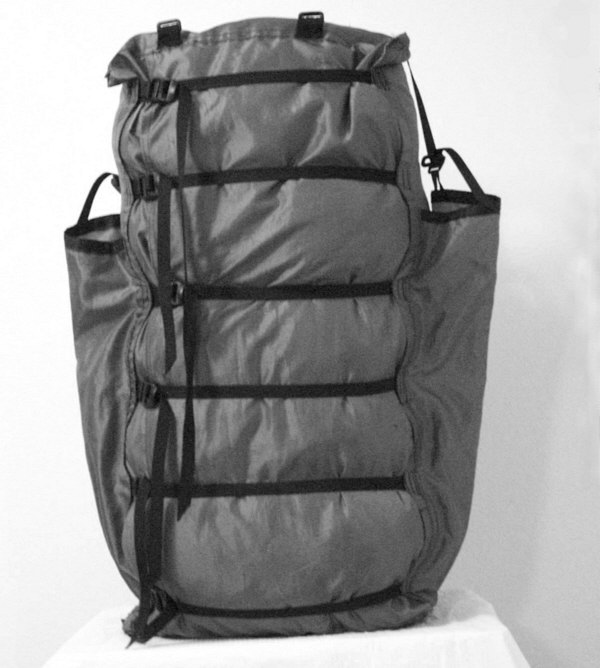
I never thought I'd do this. Making my own packs, that is. It's pretty dumb.
In a way, you can blame Glen Van Peski, or some other people. The other people are the ones who proved to me that you can actually cook over an alcohol stove and live, even if there are two of you. There were two of them.
I don't remember their names now. One was a local elementary school teacher and the other was from Australia, a guy here on a business contract. They fell in love and backpacked happily ever after. Moved to Australia. After I went on a trip or two with them. Not like being one of the honeymoon party or anything, just one of the group, a random person in a group of random persons who happened to be on the same short backpacking trips.
But I saw what they could do. All the traditional backpacking books, including Colin Fletcher's "The Complete Walker" dismissed alcohol stoves as being environmentally sensitive, compact, light, clean, quiet, and useless, because they took too long to heat anything.
Then I saw one actually being used. And it worked.
So.

There was no point in ever making a pack, or even thinking about it. Packs are complex and fussy, and hard to make. They have a lot of details. Everyone makes them, as in real companies with mass production techniques. Why bother?
So I didn't.
For a while.
Maybe it was the pain that convinced me. It has a way of getting through after a while, and I think it did. That must be it. The pain.
I never really liked the G4 pack. As in really, really, really, really, really liking it. It was designed by a particular person for his own needs, and then sold to others who didn't want to bother making their own. The man who designed the G4 is tall (compared to me). He's big (compared to me). And he does things differently (compared to me).
All fine, except when compared to me. In my world, I count. That's one of the nice things about living in my own little world. I am the emperor and make all the decrees. Everyone else has to run for cover. So when I found myself in pain, the whole empire trembled, and sought a solution. And so I eventually started making my own packs.
Even though it's dumb. Even though it's hard. Even though it's taken just about forever (I'm a slow worker). I've been dinking around for about five years now. Most of my packs worked. A couple didn't. One or two of them I had to throw right into the scrap box before they were even finished. A couple more got used once and never again.
The most famous of these single-use packs (in my world) went on my longest trip ever. It wasn't that long. I know people who have been out for months and have gone thousands of miles. That sounds like fun, but I'll never do it. Not up to it. Couldn't find the money or work out the details even if I was fit enough. But what I have done wasn't too shabby.
I went two weeks and covered 200 miles, in Olympic National Park in western Washington. In its own way it's a tough place. All up and down. Can be tiring. It was. But I learned a lot.
The pack worked fine, and then afterward I cut it up and used the fabric for other things. On about the second day one of the shoulder straps began to pull loose, but a safety pin fixed that. No more trouble. Now I sew better.
The shoulder straps weren't placed right, and cut into the back of my neck, but I know how to design around that now.

The pack wasn't stiff enough, and the way it loaded and compressed the load wasn't the best. I don't try doing things that way any more. It hurt more than it should have, but considering a food load alone of around 21 pounds (9.5 kg) and a total weight (without any water at all) of 33 pounds (15 kg), hey. It should have hurt.
This was a frameless pack. Empty, it weighed about 20 ounces (0.6 kg). Not bad. It worked.
I wouldn't have to be so loony if I'd just cooperate. Be like everyone else. Do things the right way. Be less spooky, disorganized, disagreeable, and ornery. Right. I know that. I know some people too.
I've met and talked to Glen Van Peski, Ron Moak, Brian Frankle, and looked at their goods. Learned a lot about how they make packs. I admire their work. None of them actually sew their own goods any more, but they know how to design, and how to get things done, and have access to materials, at wholesale prices, that ordinary mortals can't even find. I like their packs.
But they aren't for me.
I have a problem.
I use a hammock.
This is not a problem. This is an opportunity. A challenge. A personal characteristic. An idiosyncrasy.
OK, fine, but it gives you a nudge and shoves you over the foul line. If you use a hammock you basically have two choices. One is to buy a stiff pack that is bigger and heavier and more expensive than you need and the other is to buy a not-stiff pack that is more expensive than you need and also wiggly and too light and not durable enough and doesn't carry well.
So I chose what was behind Door Number Three.
Which was a hollow empty space with a note in it, and the note said "Make something up." So I did.
Yeah. I'm dumb. I'm a butthead. It's OK. I'm like that but I want to take control at some point, not just pull whatever off the shelf and repeat and repeat. So instead I've spent years dinking around making my own packs and getting only a little better. Half step forward, etc.

Things are different when you sleep in a hammock. This is a backpacking hammock. There are such things. Kind of a fringe development. I mostly don't mention it until someone else does, and it's funny how often someone I meet on the trail, never seen them before, says they use a hammock. Then we talk for a while but it isn't kinky any more. Sort of like an option that's there if you look for it but most people would not consider even if they'd heard of it.
The "traditional" ultralighter (I guess there is such a thing now) sleeps on the ground. Most people do, obviously. Used to be it was under a tarp of some kind, or in a bivy sack, but single wall tents are catching on too. Anyway, those who sleep on the ground need some kind of pad, for cushioning and for warmth. Ultralight pack makers depend on these to provide a pack with stiffness. Some now use a bit of a framesheet or carbon fiber stays, or maybe a hoop inside the pack to substitute for an internal frame, and the packs are getting out of the ultralight range, but the idea is that a pack, a backpack, needs some stiffness to it.
Sleeping pads come in a 20 inch width (51 cm). If you travel light you limit the length to at most 48 inches (122 cm). It takes almost no brains to fold one of these pads down to a 12 by 20 inch package, and this, in the pack, against your back, provides fair rigidity for light to medium loads. Inflatable mattresses work too. I've used them, and you can adjust the stiffness by controlling how much air they hold.
Alternately, a closed cell sleeping pad can be formed into a hollow tube, inserted into the pack, and then this can be stuffed and cinched to form a rigid cylinder.
No sleeping pad works well in a hammock. They just don't.
They are too narrow, slide around, trap body moisture next to your skin, crumple and lump up, and abrade the inside of the hammock. But mostly they are too narrow, as you'll find out if you ever use one. The big downside of a backpacking hammock is that it can be unforgivingly cold. You need adequate insulation under you, and the only decent way to get this is with an "under-quilt", a layer of soft, flexibly compliant, breathable insulation hung under the hammock and snugged up against its bottom. It doesn't take much at all, but it has to be there.
So my problem is that no pack made is made for hammock camping. A big, heavy pack works, but that's what I want to get away from. A small, light pack works, but not well, and can't carry a real load without stiffening.
How do I solve this?
My problem is that no pack made is made for hammock camping. A big, heavy pack works, but that's what I want to get away from. A standard small, light, frameless pack works, but not well, and can't carry a real load without the stiffening that a frame provides.

So how did I solve this? I began making my own packs. My guiding principles are that my pack should be:
- Small.
- Stealthy.
- Light.
- Simple.
- Convenient.
- Comfortable.
- Durable.
- Adaptable.
- Frameless.
- Hammock-friendly.
Size. I want a pack that is small. I keep trying to go smaller, but keep making them too big. The right size for me is 25 to 30 L. Also smaller at times, and bigger at other times. Hmmm.
Stealth. Color isn't too important, but I prefer a medium gray because it blends in the best. I once had a gray cat and could find it during the day if I looked, had to hunt for it at twilight, and never saw it after dark. It blended in. Green and brown are good too, as is blue-green (jade, cyan). This last color fades into the haze of those days we have at times. But overall, gray feels best for me.
Weight. Should be low, but isn't hugely critical. I've seen commercial packs at under eight ounces (227 g) but I can handle double or triple that without noticing. (My very first pack weighed 9.8 ounces or 278 g. It wasn't very good but it worked.) My upper limit is unofficially 24 ounces (680 g). Lighter is better. Heavier is not.
Simplicity. The pack has to be simple. I don't either need or want a lot of pouches and pockets and zippers and doodads but what is there should work.
Convenience. With simplicity goes convenience. What is convenient for me is probably not right for you, but I bet you could live with it. Then again, I don't care. This is my fantasy world after all, but convenience is easier to achieve through simplicity, and inconvenient simplicity is pointless.

Comfort. The pack should fit me well. I've designed packs that could be adjusted for various torsos and that's easy enough, though more bother than I want, so I no longer worry about it. The pack does need two shoulder straps and a hip belt. Some people say that hip belts are optional, or are frills, for sissies, but I suspect that they never go backpacking. A hip belt is mandatory for me. Not a waist belt or a simple strap either, but something padded that can support weight.
Durability. Also important, but not at the level of a commercial pack. I don't have to worry about returns, reputation, or lawsuits. If my pack fails I'm screwed but that isn't a legal issue, it's purely a private one. Anyway, I carry needle, thread, safety pins, extra line, and an extra webbing strap or two, plus duct tape. Mostly I'm OK. Always, in fact. My packs don't have to endure 15 years of idiot abuse. Only a season or two. Some packs I've used only once, ripping the fabric apart and folding it into the next project after I'd learned what I needed to. So.
Adaptable. A big issue for me is adaptability. This brings us back to size, and links to convenience. I need a pack that expands and shrinks as needed. It should accommodate all the food, fuel, water, and extra clothing I need, and should shrink down again as I use things up. The pack should also serve as a day pack, for carrying only a bit of food, some water, and a jacket. Luckily I have a plan.
Once upon a time I bought a Gearskin from Moonbowgear. It is a folded flap of fabric like a taco with shoulder straps and a hip belt on one side. You put your things on the first side, fold up the other side, and cinch it all down tight into a solid wad. My packs are kind of like that but not too much.
I liked the Gearskin idea but the Gearskin is hard to load (the mound of stuff keeps sliding off), and the sides and top are open. And it doesn't compress down small enough to use as a day pack. I came up with a similar idea. My packs are front loaders. The Gearskin has two sets of compression straps, one on each side. My packs have one row down the front (the side away from my back), and aside from that they are closed bags. They don't unfold at all. Formerly I had a top with an expansion collar, but abandoned that. (More simplicity.) Now the pack interior is accessible only through the front.
What I have now is a bag that's shapeless when empty but forms a rigid, light, and comfortable pack when full. There is one huge pocket on each side and that's it. To load it I put my sleeping bag in first, against the back, then lay in the folded hammock, in a U-shape around the perimeter, then add food, clothes, and whatever else. When I'm done I cinch the straps along the pack's front and pull the two sides toward each other. I keep doing that until I can't any more. The compressed pack resembles a thick vertical log with a rectangular cross section, but it's soft on my back. Soft but rigid.

The things I'll need during the day go into the side pockets. Each pocket is large enough to hold a full Platypus two-liter bladder, plus whatever else I can squeeze in. Sometimes I use a detachable pocket to carry the cook set and the day's food hanging on the front of the pack. I normally carry mass quantities of water only when seeking out a camp site.
The pack is goofy, no doubt.
It has a lot of dangly compression straps on the front, and their loose ends all have to be tucked in. The front is two overlapping flaps that part just enough to let me load and unload the pack. The side pockets are huge, and sloppy looking, but have lifters to keep them tighter than they look (though they always look loose and sloppy).
The pack expands so much (side to side) that I can get a lot in, and it shrinks down to almost nothing after my food, fuel, and water are gone.
This works for me. No one else that I know of makes anything quite like it. As long as I pack it carefully, and cinch it tight, it carries extremely well.
Frameless. The only real problem I've had, other than endangering my life at home every time I'm near the sewing machine, is that, with enough food (even a moderate load like a week's worth), the pack slumps a little, kind of creasing right above the hip belt, and bulges out away from me, a little off to one side. No matter how tight I squeeze it, it wants to do this. The Gearskin does this too. But I didn't want to get into the world of frames. It's probably a matter of less than perfect loading, but I can't fuss too much or I'd never get it loaded at all.
So I'm still working on things.
Right now I'm trying two wooden dowels as stays, one sitting vertically in each of the pack's back corners, just behind my arms. The dowels add only two ounces (57 g), and seem to be worth it. They keep the pack standing straight and tall. My latest pack is made of much heavier fabric than I've used before, and, with the stays, weighs 22 ounces (624 g). This is acceptable. I also found some really stiff foam for the shoulder straps and hip belt. It doesn't permanently deform like the stuff I was using before, so that's good too.

Durability is important but isn't a huge issue. I decided several years back that no piece of ultralight equipment should be expected to last more than one or two seasons, especially a pack. I use my gear but take care of it too, and usually overshoot my guidelines. My latest pack is made from such heavy fabric that it ought to last for several seasons, without much weight penalty at all.
Hammock-friendly. This means being able to go without a sleeping pad. My basic problem is that I can't use the standard ultralight tricks. This pack design allows me to fudge.
There are two standard ultralight tricks.
- Fold a sleeping pad and lay that into the pack, to fake a frame, or
- Roll the sleeping pad into a hollow tube, put that into the pack, and then stuff gear into the center.
Sleeping pads don't work with hammocks. That's what you try at first, but right away you realize you need something better. And then you're left with a pack problem, which is, either to use a frameless pack that hangs on your back like a large, misplaced scrotum, or to use a frame pack and forget ultralightness. So the compression idea works. Not perfectly, since you can't get a perfectly rigid pack, which is why I'm experimenting with two dowels. Better though.
Not at perfection yet but I'm getting close to a final design. I'd want tiedowns on top of and under the pack, to attach overflow bags for food and gear during long trips. For a summer week or less I can fit all my food inside the pack, but for a longer trip it would be hard. My latest pack expands from roughly 25L to 40L. Another 10L or so outside the pack would give more capacity than I could really handle, so I should be good with this size.
I might also make the top and bottom of the pack into flat flaps. Not go back to the top expansion collar idea, but build in a flap that closes tightly. Then I could stow or remove rain wear, a jacket, camera batteries, and so on. Another flap at the pack's bottom would give easy access to wading shoes and other seldom used odds and ends. Straps would keep the two flaps closed and the pack would stay rigid, tight, and taut. Right now it's miserably awkward at best to try to reach into the front of the pack, up, and get to the top (or do the opposite at the bottom).
So, to sum up, here's what I can do with my pack:
- Easily carry small, light loads on short trips.
- Easily carry medium-sized, medium-heavy loads on long trips.
- Carry as much water as I need (I make dry camps).
- Have easy access to everything I need during the day.
- Travel comfortably, securely, and stably.
- Use both hip belt and shoulder straps.
- Easily load and unload it.
- Scrunch it down to nothing when empty.
- Afford it (cost of fabric and thread, plus minor amounts of blood).
- Repair it.
- Empty, roll, and stuff it under my knees for insulation at night.
- Use it either totally frameless or stiffen it with light, cheap, removable stays.
The downside is that it takes me several days to make a new pack, and I haven't drawn up any formal plans, so every time I make a pack I have to re-invent a lot of things like exact dimensions. (OK, I'm not that bright.) Also, even though I'm lousy with a sewing machine my sewing is getting better. Seams don't disintegrate any more. And I haven't needed an ambulance during any recent sewing sessions.
Fabric is relatively cheap. I don't pay for labor, or shipping, or markup, or liability insurance. I can use scraps. I can redesign on the fly. Aside from a few hours wasted, I can make a pack, use it, figure out what's wrong, remake it, and still be ahead.
Some day, when I have plans, I might publish them, or sell kits.
Could be worse.
References:
Glen Van Peski
Moonbowgear Gearskin
Rodney Liwanag's LAB Pack
Rodney Liwanag's LAB Pack
Sleeping pad pack frame
Gossamer Gear packs
Mountain Laurel Designs
Six Moon Designs
Ultralight Adventure (ULA) Equipment